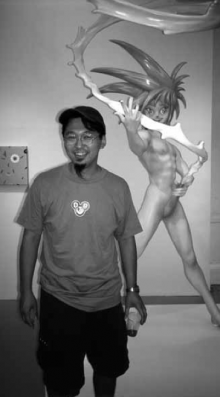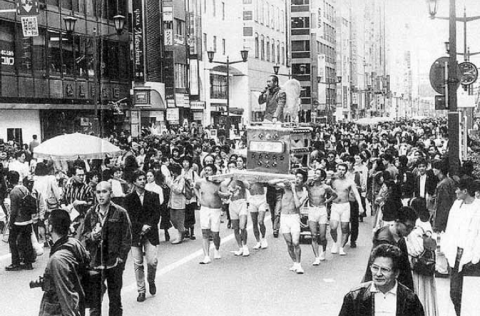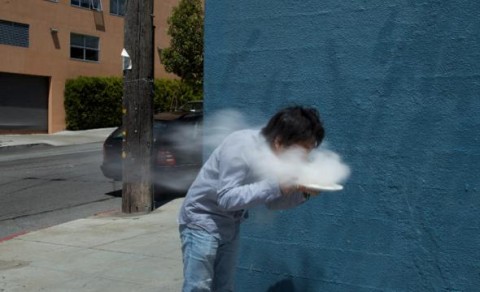News, Reviews, Reports
Reconsidering the Historical Pantheon
A review of Before and After Superflat: A Short History of Japanese Contemporary Art 1990–2011. By Adrian Favell, Blue Kingfisher Limited, 2012; 246 pages.
 The boom in Japan’s pop culture during the 1990s and 2000s was a mixed blessing, both advancing and encumbering the country’s reputation abroad. With global enthusiasm for anime and manga carrying over into the art world, this Zeitgeist for all things kawaii (cute) and kowakawaii (creepy cute) was crucial to fueling the popularity of artists such as Takashi Murakami, Yoshitomo Nara and Mariko Mori. Yet, manga and anime’s commercial success in the United States and Europe belies the drastic but little-known decline of these industries at home, and the enormous prominence of Murakami, Nara and Mori’s work on the international stage—while inspiring many—has also inevitably distracted from the wider range of ideas being explored by other artists in Japan.
The boom in Japan’s pop culture during the 1990s and 2000s was a mixed blessing, both advancing and encumbering the country’s reputation abroad. With global enthusiasm for anime and manga carrying over into the art world, this Zeitgeist for all things kawaii (cute) and kowakawaii (creepy cute) was crucial to fueling the popularity of artists such as Takashi Murakami, Yoshitomo Nara and Mariko Mori. Yet, manga and anime’s commercial success in the United States and Europe belies the drastic but little-known decline of these industries at home, and the enormous prominence of Murakami, Nara and Mori’s work on the international stage—while inspiring many—has also inevitably distracted from the wider range of ideas being explored by other artists in Japan.
In spite of the abundance of monographs on these three artists (and a handful of other globally recognized contemporary artists such as Hiroshi Sugimoto), there are very few publications in English that survey the broader context that surrounds them. With Before and After Superflat: A Short History of Japanese Contemporary Art 1990–2011, Adrian Favell, then a Professor of Sociology at UCLA, aims to fill this gap. Invited to Tokyo as a Japan Foundation Abe Fellow in 2007, Favell spent that year and several subsequent visits spending time with dozens of artists, dealers, curators, collectors, critics, and other figures. Woven together from the multiplicity of their subjective perspectives as much as recourse to black-and-white documentable sources, the book is the product of his ethnographic/observational sense of the art scene—similar in approach to Sarah Thornton’s Seven Days in the Art World (2008). Though limited to some extent by his reliance on art-world insiders as guides and translators, as a self-professed “outsider” he has more freedom to adopt the kind of candid criticality that most people in the Japanese art world would be too wary to express in public for fear of being perceived as unsupportive.
 For the first third of the book, Favell reflects on how the birth of Murakami, Nara and Mori’s practices were the product of a pre-2008 mentality in which artists had to massively increase their production values in order to achieve international recognition. The author focuses particularly on Murakami and Nara as the most consequential of the three, and analyzes their business strategies. On the one hand, Murakami, who was dissatisfied with the “lame art education, the exploitative galleries, the parochial debates, the ineffective market, and the claustrophobic schools,” sought to rebuild the Japanese art world in his own image. Adopting a top-down corporate approach, he set up his own Warhol/Koons/Hirst-style production company Kaikai Kiki, collaborated with real-estate tycoon Minoru Mori on the branding for his Mori Art Museum and the luxury mixed-use complex that houses it, and established GEISAI, a large biannual festival-cum-talent show in which participants apply and pay for a booth to show their work.
For the first third of the book, Favell reflects on how the birth of Murakami, Nara and Mori’s practices were the product of a pre-2008 mentality in which artists had to massively increase their production values in order to achieve international recognition. The author focuses particularly on Murakami and Nara as the most consequential of the three, and analyzes their business strategies. On the one hand, Murakami, who was dissatisfied with the “lame art education, the exploitative galleries, the parochial debates, the ineffective market, and the claustrophobic schools,” sought to rebuild the Japanese art world in his own image. Adopting a top-down corporate approach, he set up his own Warhol/Koons/Hirst-style production company Kaikai Kiki, collaborated with real-estate tycoon Minoru Mori on the branding for his Mori Art Museum and the luxury mixed-use complex that houses it, and established GEISAI, a large biannual festival-cum-talent show in which participants apply and pay for a booth to show their work.
On the other hand, though Nara eschews such a bombastic approach to business, Favell argues that his “slacker CEO” demeanor belies an equally calculating strategy of populist outreach in which he not only sells his paintings and sculptures to top collectors but also churns out a vast range of more affordable merchandise that has appealed to fad-obsessed hipsters the world over. Favell paints an unfavorable picture of Nara building his indie reputation off the back of “collaboration” with thousands of fans who helped construct the ramshackle, shed-like installations of his A to Z series of touring exhibitions.
While acknowledging the positive interest Murakami and Nara’s work stirred abroad, Favell concludes this section with a stark assessment of the resentment that their upending of the status quo stirred at home. In retrospect, GEISAI “undercut the efforts of galleries to build sustainable value on emerging artists’ works” and “distracted the attention of the global art media away from serious Japanese art.” Most damning of all, the author states that “GEISAI removed the need for serious art education and filled young heads full of illusionary dreams,” and posits that Nara’s “community” was little more than “a temporary refuge from reality, where costless volunteers were put to work for an artist’s brand . . . Now Cool Japan is over. Murakami and Nara’s children have nowhere to go.”
The chapter on Nara, which Favell published as an extract on his ART iT blog, recently triggered a backlash from the artist, who disputed the accuracy of numerous points. Though there are certainly factual and contextual inaccuracies (a full list of the disputed points and Nara’s responses can be found on ART iT in English and Japanese), a significant part of the controversy was fueled by the imperfect translation that Favell posted with the original text. Favell’s writing style is strewn with casual metaphors and, in an attempt to give some narrative vigor to his account of the art world, often reads as sarcastic. Writing of this kind is very difficult to translate into Japanese without sounding rude and aggressive, and some of his metaphors were rendered too literally, giving rise to further misunderstandings. Lastly, Favell’s decision not to use footnotes and rely instead on an index of the people he conversed with as his list of sources also leaves him open to attack when the facts come into question.
[Disclosure: As of August 2012, I am the director of the Tokyo Office of Blum & Poe, Murakami and Nara’s gallery in Los Angeles.]
The rest of the book shifts to a discussion of developments that have been overlooked during the past two decades. In particular, Favell examines the generation of artists who came of age during the mid-1980s, such as Makoto Aida, Parco Kinoshita, Hiroyuki Matsukage, Oscar Oiwa, Tsuyoshi Ozawa and Yutaka Sone (collectively known as the original members of the Showa 40 nen kai, or “Group 1965,” named after the year of their birth), as well as Kenji Yanobe, Miwa Yanagi, Yukinori Yanagi, Masato Nakamura and the commandN collective. Like Murakami, these artists were frustrated by the limitations of the Japanese scene—especially the dominance of the expensive rental gallery system—but rather than create new, slick brands of their own they responded with rough, neo-Dadaist absurdism, including guerilla interventions in public space.
Favell pays special attention to Makoto Aida, who after years of being a cult figure in Japan is only now receiving serious recognition with a retrospective at the Mori Art Museum in November. The author champions Aida as a true provocateur who is unafraid to broach historical and social taboos, on a par with Jake and Dinos Chapman and deserving of comparable recognition yet ignored by the art world outside of Asia. He attributes the slowness of Aida’s rise in part to his dealer Sueo Mitsuma’s decision to maintain exclusive representation of his artists rather than develop “quid pro quo international networks”—a strategy that has benefitted gallerists such as Tomio Koyama, Masami Shiraishi and Atsuko Koyanagi. Likewise, many of their most successful artists—among them Tatsuo Miyajima and Hiroshi Sugimoto—are international networkers in their own right. As Favell puts it, “Mitsuma was evidently betting on the long run. But it is still not clear that any Japanese artist can do without the gaisen kouen (triumphant return performance) if they want to make it to the historical pantheon.”
In this vein, much of Before and After Superflat is depressingly pessimistic, albeit not without reason. Favell dwells on several missed opportunities, such as the mismanagement of the second and third Yokohama Triennales in 2005 and 2008, which by failing to capitalize on the achievements of the first edition cost Japan a crucial chance to reassert itself in a regional scene now dominated by the biennales in China, Taiwan, Korea, Singapore and Australia. Likewise, he laments the ill-fated mix of pork barrel spending and underfunding of museums, using the 21st Century Museum of Contemporary Art in Kanazawa as a prime example of how smaller cities have been lumbered with institutions that are beautifully designed yet lack sufficient funding for top-quality acquisitions and exhibition planning. By contrast, the author does express hope for the future of rural events such as the Echigo-Tsumari Art Triennale and the Setouchi International Art Festival. Though not without their flaws, these “slower,” more community-based endeavors, focused on the conservation and renovation of traditional buildings as sites for art display, are more inherently sustainable—the antithesis of the dystopian corporate approach to the arts that led to the Mori Art Museum and its surrounding complex being branded as an “artelligent city.”
For the most part, Favell’s survey of recent developments in Japanese art is successful. At times, however, the narrative is long-winded and repetitious, frustratingly vague about dates and locations, and the breeziness of its tone can irritate. The author is prone to making sweeping statements, and the four pages he allocates to comparing the Japanese and Chinese art scenes—two vastly different contexts—are the weakest part of the book. There is also a handful of bizarre omissions. Taka Ishii is as important a gallerist as Mitsuma, Koyama, Shiraishi and Koyanagi, but he is referred to only once in passing, and in a passage that describes the prominence of young female dealers in the “New Tokyo Contemporaries” association of seven emerging galleries, half of those women (Atsuko Ninagawa, Misako Rosen and Yuka Sasahara) go without mention. As with some of the issues Nara raises in his list of complaints on ART iT, lapses of this kind have the unfortunate effect of casting doubt over the thoroughness of the rest of the text. Lastly, the final chapter only touches on a small number of artists born after 1975, such as Tabaimo, Koki Tanaka, Teppei Kaneuji and the Chim↑Pom collective. After being given so much detail about their predecessors, one is left wanting more.
Regardless, the full range of contemporary Japanese art remains woefully underrepresented on the international stage, and Favell has taken an important step toward rectifying that discrepancy. He plans to follow it with a more academic publication on post-bubble festivals and innovations in art and architecture in relation to regional and urban development. In spite of the book’s flaws, for those who seek a critical reflection on Japan’s most prominent artists since 1990 as well as a primer on the work of their lesser-known peers and successors, Before and After Superflat is a worthwhile start.
About & Community
A place to keep abreast of Art Space Tokyo related news, reviews, events and updates.
Art Space Tokyo is a 272 page guide to the Tokyo art world produced and published by Craig Mod & PRE/POST.
It was originally published in 2008 by Chin Music Press.
Current Tokyo exhibitions
Powered by Tokyo Art Beat


